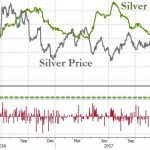Today Janet Yellen and the FOMC will go back to square one and try to reset global expectations unleashed by the ill-fated December rate “policy mistake” hike, when at 2pm the Fed will announce assessment of the economy (even if not rate hike is expected today) followed by Yellen press conference half an hour later. Just like in December the Fed will be forced to telegraph that it is hiking rates as a signal of a strengthening US, and global, economy where “risks are balanced” and hope that the subsequent global reaction will not be a rerun of what happened in January and February when confusion about the Fed’s intentions led to a global market rout.
Just as important this time around is that as of yesterday, stocks have largely entered a buyback blackout period, meaning the biggest (and according to many, the only) marginal buyer of equities has been sidelined for the next month.
Financial markets are being swayed by divergent monetary policies in the world’s leading economies. Fed funds futures show the odds of a U.S. rate increase by the end of June have shot up to 54 percent from about 6 percent in the past month as data has indicated growth has recently strengthened modestly and taken off the immediate risk of a recession off the table.

The U.S. currency will probably respond favorably to signals from the Fed, which will look to keep its options open, Alan Ruskin, Deutsche Bank AG’s global co-head of foreign-exchange research in New York, wrote in a research report. “This also means leaving the door wide open to a June hike, and even ajar to an April hike,” he wrote, saying the March payrolls report and global risk sentiment will be important deciding factors. “The market will see this as more hawkish than currently discounted.”
“We’re waiting for U.S. monetary policy so its difficult for investors to rush in and buy,” said Chihiro Ohta, general manager of investment information at SMBC Nikko Securities Inc. in Tokyo. “We need to see whether we’ll have one or two rate hikes this year, and whether the next one will come in June.”
As a result Fed officials are broadly expected to reduce the number of rate hikes they see in 2016 and leave the target range for the federal funds rate unchanged at 0.25 percent to 0.5 percent.
So as we await Yellen in a few hours, European stocks rose initially then took a modest leg lower following downbeat comments from the UBS CEO detailing that 2016 has remained a challenging year for the company while markets speculated about the Credit Suisse CFO dropping out of a Morgan Stanley conference. The sentiment has now breached into the broader European sphere with the likes of Deutsche Bank lower by 2.2% and European stocks in the red. Asian equities fell as Japan’s Topix extended Tuesday’s retreat from a five-week high, while China closed modestly higher after Premier Li Keqiang said that China isn’t headed for a hard landing and the government will ensure expansion hits targets.
Meanwhile, WTI has halted its 2-day slide after API data overnight showed U.S. crude stockpiles climbed last week around half expectations for today’s more definitive EIA data. The price extended gains gains after Qatar said it would host an April producers meeting where the topic would be what else, a production freeze, one which however would not include Iran; Brent recovers above $39, moving in parallel w/ WTI market.
“OPEC/non-OPEC is doing its best to keep the verbal intervention going, indicating a production freeze might be done without Iran’s participation,” said Ole Hansen, Saxo Bank head of commodity strategy. “Prices have also been helped by API data yesterday. We broke some technical levels and that attracted selling, but with the API data and renewed talk of an April mtg this has enabled prices to resume higher.”
The dollar strengthened against most major currencies while US equity futures are broadly unchanged.
Market Snapshot
Top Global News
Looking at regional markets, we start in Asia where stocks traded mixed following the lacklustre close from Wall St. with price-action muted as participants remained cautious ahead of today’s FOMC decision. ASX 200 (+0.2%) saw choppy trade as financial and tech gains counter-balanced weakness in material names. Nikkei 225 (-0.8%) underperformed amid losses in financials and a firmer JPY post-BoJ policy decision, while Sharp shares declined around 10% as Foxconn continued to delay a deal agreement. Chinese markets were also indecisive amid a lack of catalysts to spur trade, with the Shanghai Comp (+0.2%) relatively flat. 10yr JGBs initially extended losses following yesterday’s BoJ inaction although prices have rebounded from their worst levels, with the BoJ in the market for JPY 1.27tr1 of government debt ranging from 1yr-10yrs.














Leave A Comment